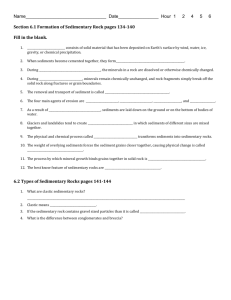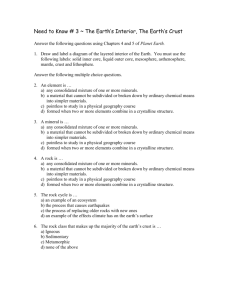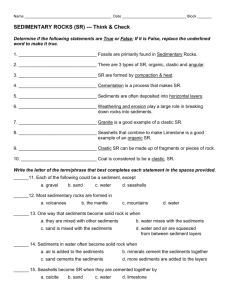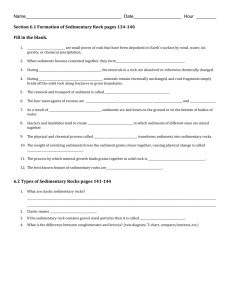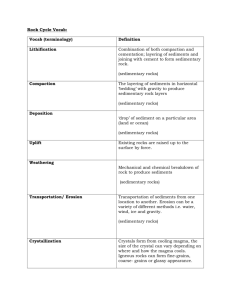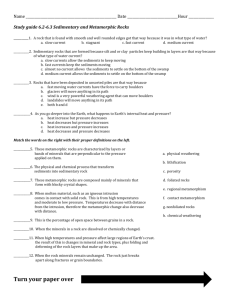Lesson Four - Virtual Quarry
advertisement
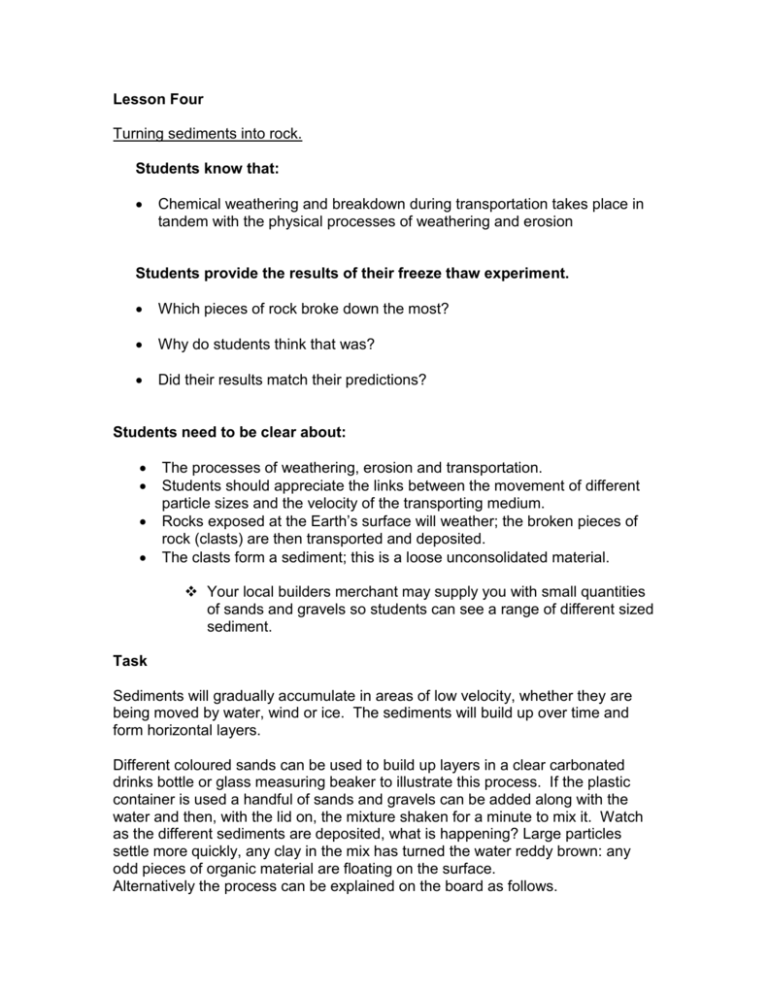
Lesson Four Turning sediments into rock. Students know that: Chemical weathering and breakdown during transportation takes place in tandem with the physical processes of weathering and erosion Students provide the results of their freeze thaw experiment. Which pieces of rock broke down the most? Why do students think that was? Did their results match their predictions? Students need to be clear about: The processes of weathering, erosion and transportation. Students should appreciate the links between the movement of different particle sizes and the velocity of the transporting medium. Rocks exposed at the Earth’s surface will weather; the broken pieces of rock (clasts) are then transported and deposited. The clasts form a sediment; this is a loose unconsolidated material. Your local builders merchant may supply you with small quantities of sands and gravels so students can see a range of different sized sediment. Task Sediments will gradually accumulate in areas of low velocity, whether they are being moved by water, wind or ice. The sediments will build up over time and form horizontal layers. Different coloured sands can be used to build up layers in a clear carbonated drinks bottle or glass measuring beaker to illustrate this process. If the plastic container is used a handful of sands and gravels can be added along with the water and then, with the lid on, the mixture shaken for a minute to mix it. Watch as the different sediments are deposited, what is happening? Large particles settle more quickly, any clay in the mix has turned the water reddy brown: any odd pieces of organic material are floating on the surface. Alternatively the process can be explained on the board as follows. Working together in class answer the following questions so a series of diagrams can be created on the board to show how sediments are turned into rock. 1. How are sediments moved away from their point of origin? 2. What is meant by deposition? What changes must occur before deposition can take place. Where might it take place? 3. The sediments are laid down horizontally. Why? All students will need the following information 4. The sediments build up over time, they can build up to 1 km thick. What will happen to the sediments at the bottom of the pile as more and more weight is placed on top of them? 5. At the bottom of the pile things are hotting up, the water still trapped in the sediments is being heated. What might happen to the minerals this heated water comes into contact with? Answers 1. Sediments are moved by water, ice or wind away from their place of origin. The velocity of the medium in which they are travelling will determine how far they move from that source before they are deposited. 2. Deposition can take place in rivers, lakes, on beaches or in shallow near shore environments. The velocity of the transporting fluid must drop in order for sediments to be deposited. 3. The sediments will build up in layers over time in the order in which they were deposited i.e. one layer on top of another. This is the burial stage. 4. As sediments build up those at the bottom of the pile are compressed and compacted. Some of the spaces between the grains will be eliminated, those remaining are known as pore spaces. Some of the water trapped in the sediments will be expelled. 5. At a depth of about 1 km any water left in the sediments will have become hot. The hot fluid dissolves some of the minerals in the sediments. The fluid flows into the pore spaces. Eventually the fluid becomes supersaturated, it is unable to hold any more of the dissolving minerals and so expels some of the dissolved mineral it is already holding. The mineral precipitates on the clasts and acts as cement binding the clasts together. 6. The loose sediments at the bottom of the pile have now become rock, this final stage of the process is known as lithification. This type of rock is described as a clastic sedimentary rock, sandstones and mudstones are both clastic sedimentary rocks. Task For this session you will need a range of clastic sedimentary rocks, rocks formed from the weathered remains of other rocks. Task: Work with a partner to investigate the properties of each rock sample. Geologists always talk to each other about what they have found and share their ideas; you should do this as well. Prediction Poorly cemented clastic sedimentary rocks will weather quickly To test the prediction: Place a piece of white paper or card on the table in front of you. Take one of your sedimentary hand samples and rub it very hard for about 20/30 seconds with a piece of wood whilst holding it over the paper. Count the grains that have fallen onto the paper and record this number next to a description of the rock sample on a recording sheet. Do the same with another two samples. It is important that you rub each piece of rock equally hard and for the same length of time otherwise you will not have a ‘fair test’. Which piece of rock do you think will weather quickly? Why? Do you think these rocks will weather more quickly that the igneous rocks you have learnt about? Why? Student feedback should enable a table to be drawn up on the board/OHP to show the most easily weathered rock through to the most resistant rock. They should be able to identify the importance of strong cement in providing some resistance to weathering. When attempting to determine if clastic sedimentary rocks will weather more quickly than igneous rocks students may need reminding that igneous rocks are formed from crystals, which are interlocking. This is a much stronger structured than cemented grains regardless of the strength of the cement. What do students think happens to the weathered particles from their sedimentary rocks? Introduce the idea of recycling, nature is constantly recycling materials, in this instance weathered particles will be eroded, transported and deposited and the process of making a new clastic sedimentary rock will begin. Why is it important for us to understand the way in which rocks weather? Links to building stones, materials used for bridges, houses, stone walls etc. Homework Use the internet to find out about the following structures which are found in sedimentary rocks. Use drawings to show how the structures were formed. What do the structures tell us about the way in which the sediments were laid down? What can the structures tell us about where the sediments were laid down? Cross bedding Ripple marks Dessication cracks



